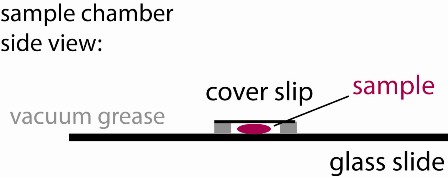Procedure: Diffusion in biological gels
You are going to work with sensitive biological samples, so wear gloves at all times when you prepare the sample to avoid contamination!
Part I: finding a suitable particle dilution
You are going to test the diffusion behavior of three different particle types in matrigel. The three particle species are:
a) 1 µm liposomes, positively charged
b) 1 µm liposomes, neutral
c) 100 nm polystyrene beads, positively charged
You first have to determine a suitable particle concentration for your tracking experiment. You want to have more than 1 particle per ROI for tracking but not too many particles (since then the contrast will suffer). Since the particle concentration in the stock solutions you are given is quite high, you have to find an appropriate dilution for each particle type. All particles are labeled with a red fluorophore. You can vortex the particle solutions before use to disassemble clusters.
1) Prepare a dilution of your stock solution (10-50 µl will do). For better comparability to later experiments, add 1 µl of your particle dilution to 50 µl of water to create a ”sample”.
2) Use the vacuum grease filled syringe to place an open ~ 15x15 mm square on the middle of a glass slide. Make sure it is small enough so that it can be fully covered with a cover slip. Ensure that the linings are continuous (see figure), otherwise your sample chamber will leak and you will have lots of drift.
3) Place ~30 µl of your first sample into the vacuum grease well of the sample chamber you have crafted in step 2. Cover it with a cover slip creating a sandwich (see figure). Label the glass slide to keep track of your sample.
Repeat steps 1-3 until you have found suitable dilutions for all three particles.
Part II: preparing the gel/particle mixtures
1) Defrost a 75 µl aliquot of matrigel on ice.
2) Once the gel has thawed, distribute 25 µl each into a total of 3 small test tubes and keep them on ice as well.
3) Dilute two of these 25 µl aliquots 1:1 with DMEM and the third aliquot with the salt solution you have received to a total of 50 µl each; mix by gentle pipetting, avoid creating bubbles! NEVER vortex the protein solution! Keep the aliquots on ice while diluting.
4) Add 1 µl of a particle dilution you created in part I to the diluted gel solutions: use neutral liposomes for the first of the DMEM aliquots and positively charged liposomes for the second DMEM aliquot. Add the polystyrene particles to the aliquot with the salt solution. Mix the particles in by gentle pipetting, avoid creating bubbles! Label your test tubes accordingly to keep track of your sample mixtures! You should now have three aliquots containing 51 µl of a gel/particle mixture each. Keep all the aliquots on ice!
5) Craft and fill three sample chambers as in step 2 and 3 of part I. Fill each sample chamber with a different sample and label the glass slides accordingly.
6) Place all of your filled sample chambers for 20 minutes in the incubator at 37°C to induce gelation.
7) Your hydrogel samples are now ready for microscopy.


